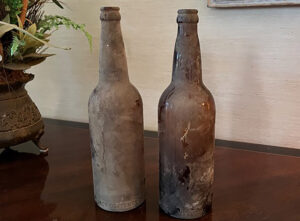 GJ found two “blob top” straight-sided shorter-necked low shouldered amber-brown glass twenty-three ounce beer bottles wedged between the ceiling joists in his 1890s house below APS. Each appeared slightly different and covered with 134 years of dust gathered in their final horizontal resting place among the lathe and plaster. GJ installed a new ceiling fan a few months ago in the ground floor bathroom when these bottles saw the light of day after over a century.
GJ found two “blob top” straight-sided shorter-necked low shouldered amber-brown glass twenty-three ounce beer bottles wedged between the ceiling joists in his 1890s house below APS. Each appeared slightly different and covered with 134 years of dust gathered in their final horizontal resting place among the lathe and plaster. GJ installed a new ceiling fan a few months ago in the ground floor bathroom when these bottles saw the light of day after over a century.
GJ’s house is one of the few original old homes in the “Hawley Heights,” a ‘speculation’ acreage with plans for many houses designed by entrepreneur Walter N Hawley. He wanted to capitalize on the local land boom in 1887, that disappeared after the early 1890s. We have two remnants of that era in those two old bottles.
What beverage did those bottles contain?
The bottles contained twenty-three ounces of beer each. Compared to modern long-neck bottles which contain twelve ounces, a ‘shorty’ contained seven ounces with a higher alcohol content by volume than today’s average beer. Drinkers in 1890 really DRANK. The average alcohol content today is five to six percent by volume. The beer contained in these two bottles had an alcohol content of five-and-a-half to seven percent. People considered beer safer than water because of the prevalence of waterborne diseases. The alcohol used in the brewing of beer purified the water used. In both England and the US in the 1890s mild ales comprised more than seventy percent of the beers sold in bottles. Lager came into style at this time because of the influx of German immigrants to the US. Dealers mostly sold draft beer in kegs.
So, they sold stronger beer in larger servings in 1890. I assume the drinkers whose lips last touched these two bottles stood on ladders to work on ceiling joists while drinking. But their ages might indicate stamina. Municipalities or counties legislated average drinking age in much of California. The age of sixteen years in Santa Barbara at that time. Other counties established the advanced age of eighteen years. Thus, we have young, tough, drinkers perched on GJ’s roof 134 years ago.
Beer not bottled widely in the US before 1873
The beer bottle was invented in the early 1700s in glass form, resembling wine bottles with long necks and sloping shoulders, “stoppered” by a plug. Beer was kept in kegs, stored in barrels, and until 1870 served at room temperature. By the end of the 19th century, beer bottles looked like modern bottles cast in a mold (not blown glass) with short necks and low shoulders. GJ’s bottle is “transitional” with almost all cast in a mold but for the “blob tops,” globs of blown glass. They didn’t seal them with a metal top, but with a stopper. The ‘blob’ functioned to keep these bottles extremely sturdy when shipped by train or wagon to prevent chipping.
GJ pointed out that they’re both different in the necks. This is because by 1890 the US beer brewing industry became huge, and bottle companies made special bottles for various breweries. One of the big bottle firms, Reed and Co, also made the same twemty-seven ounce bottle, most similar today to our “Bomber” bottles holding twenty-two ounces, “Belgian style” (1/6 of a US a gallon) called a deuce deuce or double deuce by “Zytophiles” – lovers of beer.
The Color?
They became brown before the modernization of the beer bottling industry because brown glass blocks out UV rays that make beer “skunky” and also blocks out oxygen to keep beer fresher. Less effective green glass bottles became a signature of European bottlers. Shorter, less voluminous brown bottles popped up post 1930s to compete with the growingly popular beer can. Similar to GJ’s bottles, Coca Cola in the 1890s bottled Coke in the same shaped bottle but at eight inches, also brown glass. Quite an evolution from 1800 BC when workmen between the Tigris and the Euphrates sipped beer through straws from Sumerian jars.
You might ask about the purpose of “shoulders” on a beer bottle. They designed the beer bottle with that shape for a reason. On that slope rests residue and dregs (pre-filtering technology), so when you pour the beer it is ‘cleaner.’
The value of the pair is $100, but the story is more valuable.